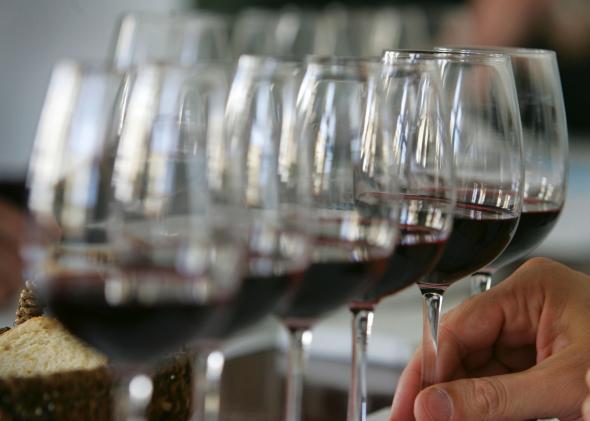Perhaps the relationship between the gods and the grape peaked early—way, way back in the ancient days when mortals on all continents offered libations to the divine. If Livy’s History of Rome is to be believed, the matter reached its absurd extreme with the Bacchanalian rites—a cult practice as wetly ecstatic as the pool scene between Neve Campbell and Denise Richards in Wild Things: “When wine, lascivious discourse, night, and the intercourse of the sexes had extinguished every sentiment of modesty, then debaucheries of every kind began to be practiced.” And not just the fun kind, either. Livy wrote that the boisterous worship of the deity formerly known as Dionysus was an occasion for blood-spilling sin: “On account of the loud shouting, and the noise of drums and cymbals, none of the cries uttered by the persons suffering violence or murder could be heard abroad.”
Things have quieted down in recent centuries. In Islam, alcohol is haram, and there is no place for it in Muslim rituals. Buddhists frown upon drinking, as it may cause erratic driving on the Noble Eightfold Path. Hindus recognize a place for herbal wine in Ayurvedic medicine but don’t make a big thing of it. Wine is of course essential to the Eucharist, and Christians with perceptive palates will note that some fine churches rely on port or Madeira for transubstantial matters; as fortified wines, these stay fresh for a while. But considered strictly as a matter of volume, the official Christian consumption of wine is not very significant; believers are never called upon to drink in Marriage-at-Cana-type quantities. Surely the largest oenophiliac faith is Shinto. Sake—Japanese rice wine—is omnipresent in Shinto ritual, with barrels stacked at shrines, traditional nuptial cups exchanged at wedding ceremonies, and non-traditional shots slammed at wedding-reception after-parties. Meanwhile, atheists tend to prefer vintages that pair well with flying spaghetti. That, or whiskey. And religions that expressly mandate Kool-Aid as a sacrament are best avoided, no doubt.
This brings us to Judaism, and the annual feast of Passover Seder, with its obligation to drink four cups of sanctified wine. There are many kosher-for-Passover wines out there, including some that deliver qualities other than the full sweetness traditionally associated with the category, but only the best-seller is a cross-cultural icon—Manischewitz.
Why is this wine different from all others? Well, for one thing, it is not too very different from some of monotheism’s other grape-based contributions to American life. The most famous of Manischewitz’s many varieties is made with Concord grapes—a fruit first bred in a Massachusetts town with a Transcendentalist vibe, by a horticulturalist who required a lot of self-reliance to devise a grape able to withstand Northeastern winters. Concord Manischewitz bursts on the palate with precisely the nuance of Welch’s grape juice, a quality it shares with the products of a few notable sacramental wineries favored by Catholics. (Not for nothing, Thomas Bramwell Welch was Methodist in religion and prohibitionist in his politics; he originally pitched “Dr. Welch’s Unfermented Wine” as a non-alcoholic communion alternative.) It’s a big-tent flavor, happily humble, and agreeable to an unpracticed palate.
For this very reason, Manischewitz has long been a favorite among undiscerning gentiles—it’s the one wine of the Chosen People to choose when you’re not feeling choosy. According to Robert C. Fuller’s Religion and Wine: A Cultural History of Wine Drinking in the United States, Manischewitz wine “originated more or less by accident,” after one Leo Star, who had been selling a kosher Concord wine labelled Mount Zebo, experienced a surprise uptick in sales in the 1930s. Star entered a business agreement with a company already trusted for its matzo before realizing that non-Jewish drinkers were driving demand. As attested by pages in Life magazine, a TV commercial starring Sammy Davis Jr., and the work of everyone’s favorite fictional ad agency, Manischewitz offered a respectable fruity pleasure to tongues that were, though not very highly discerning, too genteel for a syrupy Concord-based “bum wine” such as the notorious Wild Irish Rose.
I believe that wine snobs, cocktail nerds, and American Studies specialists alike ought to spend some time with this beverage, which is presently available way cheap at any diverse liquor store, probably at a location convenient to the register. Those of you with an appetite for the slightly ridiculous might try the Drunken Pharaoh cocktail featured in the New York Times a few years back—bourbon, Manischewitz, lemon juice, and club soda, served in a glass rimmed with crushed matzo. “While the Manischewitz’s cloying sweetness comes through,” wrote Jonathan Miles, “the drink is determinedly balanced, and rather festive to boot.” More modestly, you might goof around experimenting with Manischewitz cobblers, rickeys, smashes, and brambles. Most meaningfully, from an anthropological perspective, you might sip on it while reading over Fuller’s ideas about ritualized potables. It’s possible, his scholarship suggests, “that the gradual incorporation of moderate wine drinking during religious ceremonies during the biblical era was instrumental in displacing the pagan gods who were frequently worshipped in orgiastic drinking ceremonies.” Is Manischewitz a good wine? No, but as made, for Passover, with cane sugar, it’s not an awful one. And on some level, it is nearly great—a lip-smacking cultural artifact.
